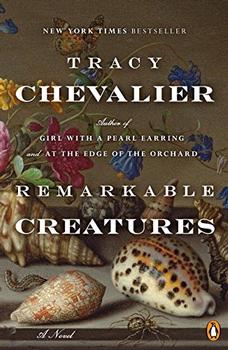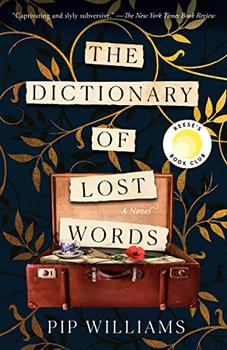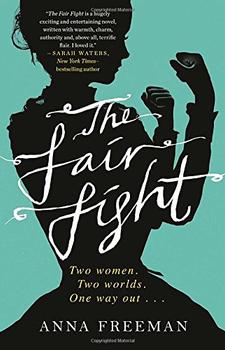Summary | Excerpt | Reading Guide | Reviews | Beyond the book | Read-Alikes | Genres & Themes | Author Bio

Tracy Chevalier, of Girl with a Pearl Earring fame, has shown before that she is not afraid to tackle popular material. Exploiting a beloved historical icon in fiction is risky business, but Chevalier dives in with gusto. Mary Anning, her subject in Remarkable Creatures, is a rock star to the natural history museum set, a feminist hero dangled before little girls to get them excited about science and to prove that paleontology is not just for boys. Chevalier takes us directly inside Mary Anning's mind, using intimate first-person confessions to construct a vision of how the junior scientist grew up, and to illustrate just how fraught her relationship with nineteenth-century science really was.
The novel unfolds in alternating first-person accounts, Mary Anning's version of events corroborated (or contradicted) by the reflections of her more educated friend, Elizabeth Philpot. Mary Anning's voice is working-class and irreverent - she likes to give her fossils cutesy nicknames like "curies" and "ichies." Elizabeth Philpot is spinsterish and irritable. She chides herself when she realizes she has been condescending, haughty, or irrational.
The style of the novel took some getting used to. When I read historical fiction I want to be shown around like a tourist. I want to read baroque descriptions of the houses, the costumes, the food. This novel doesn't work that way. Chevalier doesn't let you look around too much at the furniture in the period rooms, but she does let you see the furniture of the characters' minds. Mary Anning and Elizabeth Philpot are both well furnished with the constraints of their time - class friction, social expectations, religious prejudice, and financial limitation. Both women endeavor to free themselves, not just from the external constraints, but also from the internalized ones. Both women struggle to make room for their abiding scientific curiosity and intellectual hunger. Chevalier takes two unmarried natural history buffs and makes them, by her use of the first-person, lyrical and introspective. The portraits that emerge are interesting and nuanced, but I do have one quibble - Chevalier doesn't go far enough in showing the intellect at work. Her Mary Anning can seem at times like an idiot savant, whereas the real Mary Anning must have been incredibly sharp and precise to do the work she did, to know what she was seeing when she discovered something on the beach and to understand how all the intricate pieces fit together.
Of course the elephant in the room, for a novel set in this particular place and time, is Jane Austen. Jane Austen visited Lyme Regis on several occasions, and set part of Persuasion there. Chevalier deals with Jane head on, and not without a sense of humor. Marriage plots simmer in the background of the story, particularly in the failed romances of Elizabeth Philpot's sister Margaret (who is herself a novel reader and Jane Austen fan). Chevalier's heroines, however, exist on a different plane than Austen's wordy, witty women - Mary Anning and Elizabeth Philpot are more stubborn and more dull. They have more in common with ladies from Elizabeth Gaskell's literary universe (like the spinsters in Cranford) than with any Bennet sisters.
In the end it is in the exploration of the slow, dogged ways these two women construct their independent lives, and the emerging friendship between them, that Remarkable Creatures achieves something truly unexpected. There is no drumming romance plot pulling the narrative along - the friendship is the real crux of the novel. Chevalier takes a sensational figure (and Mary Anning was a real celebrity in her own day) and focuses on the quiet, unsensational part of the story. In this way she achieves something radical - a new way of imagining the inner lives of women who were remarkable in their day, not as spectacular rebels, but as original individuals stubbornly pursuing what interests them. I had expected to come away from the novel with some feminist insight into Mary Anning, but what I got was even more subtle and surprising.
![]() This review was originally published in The BookBrowse Review in February 2010, and has been updated for the
November 2010 edition.
Click here to go to this issue.
This review was originally published in The BookBrowse Review in February 2010, and has been updated for the
November 2010 edition.
Click here to go to this issue.

If you liked Remarkable Creatures, try these:

by Pip Williams
Published 2022
In this remarkable debut based on actual events, as a team of male scholars compiles the first Oxford English Dictionary, the daughter of one of them decides to collect the "objectionable" words they omit.

by Anna Freeman
Published 2016
The Crimson Petal and the White meets Fight Club: A page-turning novel set in the world of female pugilists and their patrons in late eighteenth-century England.
Your guide toexceptional books
BookBrowse seeks out and recommends the best in contemporary fiction and nonfiction—books that not only engage and entertain but also deepen our understanding of ourselves and the world around us.